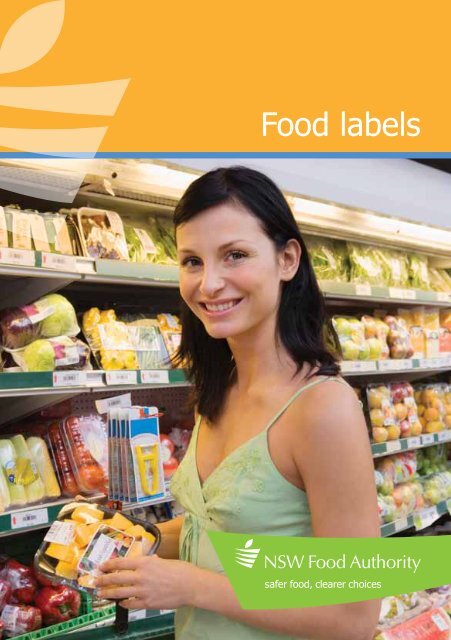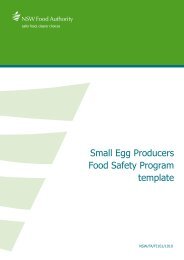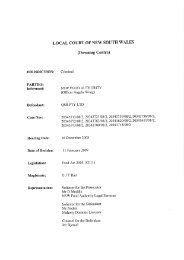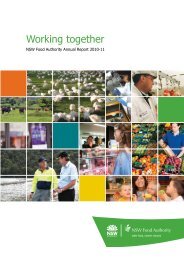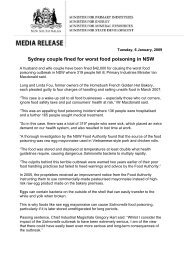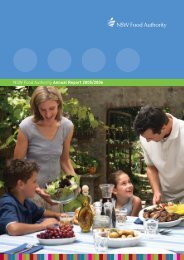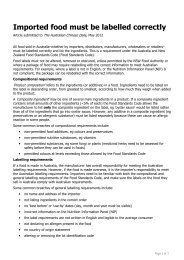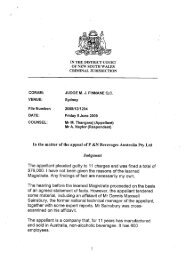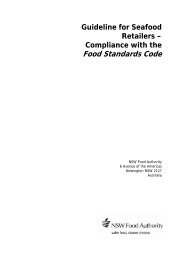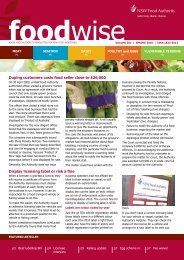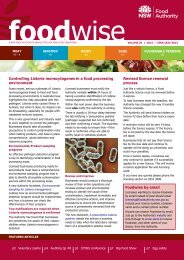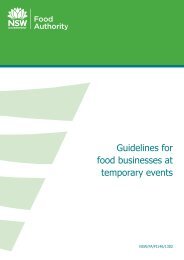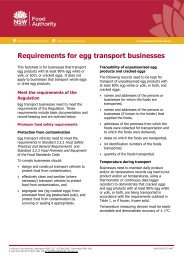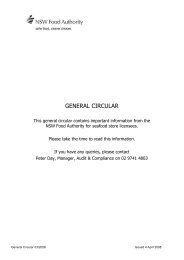Brochure: Food labels - NSW Food Authority
Brochure: Food labels - NSW Food Authority
Brochure: Food labels - NSW Food Authority
You also want an ePaper? Increase the reach of your titles
YUMPU automatically turns print PDFs into web optimized ePapers that Google loves.
<strong>Food</strong> <strong>labels</strong>
2<br />
Why do we have food <strong>labels</strong>?<br />
<strong>Food</strong> <strong>labels</strong> provide information to help us make healthier<br />
and safer food choices. They do the following:<br />
• Tell us which nutrients, in what amounts, are in a product<br />
• Warn us if a food contains food allergens<br />
• Inform us if the food is fresh or out of date<br />
• When necessary, explain how to store, prepare or cook the food we buy<br />
• List product ingredients<br />
• Give us information on where the food was produced and which<br />
company has marketed it<br />
Essentially, food <strong>labels</strong> are there to provide us with basic information about<br />
what is in the food we eat and how best to handle it.
What information must be included on a food label?<br />
In Australia, all food <strong>labels</strong> must conform to the Australia New Zealand <strong>Food</strong><br />
Standards Code. The <strong>Food</strong> Standards Code states that all food <strong>labels</strong> must identify<br />
the following information:<br />
• Name and description of the food<br />
• Identification of the lot number (food recall information)<br />
• Name and Australian street address of the supplier of food<br />
(food recall Information)<br />
• List of ingredients<br />
• Date mark<br />
• Nutrition information panel (NIP)<br />
• Country of origin of the food<br />
• Warning and advisory statements<br />
Where can you find this information on a food label?<br />
<strong>Food</strong> Recall<br />
Information<br />
Nutrition<br />
Labelling<br />
Percentage<br />
Labelling<br />
Ingredients<br />
List<br />
Allergy<br />
Statement<br />
Country<br />
of Origin<br />
<strong>Food</strong><br />
Additives<br />
Date Mark<br />
Name and<br />
Description<br />
of <strong>Food</strong><br />
Storage<br />
Requirements<br />
3
4<br />
Name and description of food<br />
All food <strong>labels</strong> must give a name for the food which is either prescribed by the <strong>Food</strong><br />
Standards Code, eg infant formula, or is a name/description that describes the true<br />
nature of the food, eg cheese spread. Under Fair Trading and <strong>Food</strong> laws, these<br />
names must be accurate and not misinform or deceive the consumer.<br />
A food with a picture of a banana on the label must contain bananas.<br />
If it contained banana flavouring rather than real bananas, it must<br />
be labelled as ‘banana-flavoured’.<br />
Ingredients list<br />
Ingredients are always listed from greatest to smallest by how much they weigh<br />
(including any added water) at the time they are added to the product.<br />
Where there are small amounts of multi-component ingredients (under 5%) <strong>labels</strong><br />
may list the composite ingredient only, eg tomato sauce, rather than listing the<br />
ingredients contained in the sauce itself.<br />
However, any additive within a composite ingredient, performing a function in the<br />
final food, eg a preservative, must be listed.<br />
INgReDIeNtS<br />
Whole milk, concentrated skim milk, sugar, strawberries (9%), gelatine,<br />
culture, thickener (1442).<br />
Characterising ingredients<br />
Sometimes within ingredients lists, you’ll see a percentage in brackets next to a<br />
particular ingredient, eg apples (26%). This is known as characterising ingredient<br />
labelling and lists the proportion of the ingredient/component included in your<br />
chosen product, ie what percentage of your apple pie is apple. Remember,<br />
apple-flavoured means just that! If it’s labelled as ‘flavoured’ you may not find<br />
actual apples in the ingredients list at all.<br />
The declaration of the characterising ingredient is required when that ingredient has<br />
been highlighted, in words or pictorially, on the <strong>labels</strong> or advertisement.
Nutrition labelling<br />
Nutrition information helps you keep track of what you’re eating and enables you<br />
to choose between different products to get the best one for you. The nutrition<br />
information panel (NIP) helps you compare key nutrients and serving sizes while<br />
some food <strong>labels</strong> will also include information on percentage daily intake and<br />
nutrition claims too.<br />
Nutrition Information Panel (NIP)<br />
Use these panels to compare the key nutrient contents, eg salt (sodium), sugar,<br />
carbohydrate and fat, of the food you buy to make sure you get the best balance<br />
for your dietary needs.<br />
The <strong>Authority</strong> has produced a wallet card explaining how to correctly read the<br />
nutrition information panel on food products. You can order copies of these cards<br />
by phoning 1300 552 406.<br />
NutRItION INFORMAtION<br />
ServINgS Per Package: 3 ServINg SIze: 150g<br />
QuANtIty PeR SeRvINg QuANtIty PeR 100g<br />
Energy 608kJ 405kJ<br />
Protein 4.2g 2.8g<br />
Fat, Total 7.4g 4.9g<br />
- Saturated 4.5g 3.0g<br />
Carbohydrate 18.6g 12.4g<br />
- Sugars 18.6g 12.4g<br />
Sodium 90mg 60mg<br />
5
6<br />
Comparing products using Quantity per Serving and<br />
Quantity per 100g<br />
If you want to compare two similar products it’s best to check if they have the same<br />
serving sizes first. If not, then compare the nutrient content (eg grams of fat) using<br />
the Quantity per 100g column to ensure you’re comparing like with like.<br />
If 20 grams of fat is listed in the ‘per 100g’ column, this means the<br />
product is 20% fat and a high fat food.<br />
It’s also a good idea to keep an eye on how many serves there are in the pack. If<br />
you only eat half the serve amount, then you’ll need to halve the quantity per serving<br />
values shown. Similarly, if you eat two serves, you’ll need to double the same values.<br />
Percentage daily intake<br />
Some food products also list percentage daily intake information. You may find this<br />
within the nutrition information panel, eg 6.4g of dietary fibre is 21.3% of your daily<br />
intake, or pulled out separately as ‘this food contains 21.3% of your daily fibre needs’.<br />
Percentage daily intake refers to how much an average adult male should eat in one<br />
day. Most women and children would need less than this, eg a food which provides<br />
10% of the recommended kilojoules for an adult male may provide 20% of the<br />
recommended kilojoules for a child.<br />
Nutrition claims<br />
Nutrition claims appear frequently on food <strong>labels</strong>. Some common ones you may<br />
have seen include ‘low fat’, ‘reduced salt’ or ‘good source of calcium’.
Currently, many of these nutrition claims are managed through a voluntary code,<br />
which meets specific criteria set by <strong>Food</strong> Standards australia New zealand (FSaNz).<br />
Manufacturers should not make specific claims such as ‘low in fat’, ‘high in fibre’, ‘reduced<br />
sugar’ unless they meet these criteria.<br />
• Low Fat foods = 3g of fat or less per 100g<br />
• Reduced Fat foods = 25% less fat than the regular product and at least 3g<br />
or less fat per 100g<br />
• Low Salt foods = 120mg of sodium or less per 100g<br />
While nutrition claims are useful guides, you should still check the nutrition<br />
information panel. even if a food says ‘low in fat’, it could still be very high in salt.<br />
Health claims<br />
Health claims are statements that link eating a specific food with reducing the risk of an<br />
illness or disease, eg ‘eating low fat yoghurt reduces your risk of osteoporosis’. currently,<br />
it is illegal to use health claims in Australia. The only exception to this is food with added<br />
folate. Manufacturers are allowed to state that eating folate just before conception and<br />
during pregnancy helps to reduce the risk of spina bifida in babies.<br />
For more information on nutrition and the current prohibition of health claims visit<br />
www.foodstandards.gov.au<br />
<strong>Food</strong> additives<br />
<strong>Food</strong> additives are used for many reasons including making processed foods easier to<br />
use, more flavoursome, or ensuring food is preserved safely. Some food additives are<br />
naturally derived, others are from synthetic sources.<br />
All food additives must be approved by FSANZ after rigorous assessment to check<br />
their safety. They must also be used in the lowest quantity possible to still perform<br />
their specific use. commonly used food additives include emulsifiers, flavour<br />
enhancers, preservatives, food acids, colouring and raising agents.<br />
<strong>Food</strong> additives are listed in the ingredients list by their functional<br />
name and also by a number or chemical name, eg flavour enhancer<br />
(621 or monosodium glutamate).<br />
7
8<br />
Allergen, advisory and warning statements<br />
If a food contains one of the eight most common food allergens – crustaceans,<br />
eggs, fish, milk, peanuts, soybeans, tree nuts, sesame seeds and their products –<br />
in an ingredient or compound ingredient, then it must be declared on the label no<br />
matter how small the amount. This declaration usually appears in the ingredient<br />
list. Sometimes food can also inadvertently contain traces of an ingredient from the<br />
harvesting, storage or processing equipment. If this is the case, the manufacturer<br />
may voluntarily include a warning, eg ‘may contain traces of nuts’.<br />
Separate advisory statements must be made on the label for the<br />
following ingredients:<br />
• aspartame – ‘contains phenylalanine’<br />
• added caffeine in cola drinks – ‘contains caffeine’<br />
• guarana – ‘contains caffeine’<br />
• Quinine – ‘contains quinine’<br />
• Unpasteurised egg products – ‘unpasteurised’<br />
The eight most common food allergens, gluten and sulphites must always be listed<br />
in the ingredients list or in a separate advisory statement. Products containing royal<br />
Jelly must also provide a warning statement on the food label.<br />
Look for warning statements like ‘contains peanuts’ or ‘contains<br />
dairy products’, or ‘starch (wheat)’.<br />
These warning statements exist to protect people with food allergies, sensitivities or<br />
intolerances from unknowingly exposing themselves to potential health risks.<br />
For further information on food allergies and intolerances,<br />
including labelling requirements, visit:<br />
www.foodauthority.nsw.gov.au/consumers/problems-with-food/allergy-and-intolerance<br />
Alternatively, you can order our <strong>Food</strong> Allergy and Intolerance brochures or Allergen<br />
cards by phoning 1300 552 406.
Date mark<br />
<strong>Food</strong> <strong>labels</strong> have date marks to tell us about the shelf life of foods. These date<br />
marks help us tell how long food can be kept before it begins to deteriorate.<br />
All food with a shelf life of less than two years must be date marked. Many canned<br />
foods, such as baked beans, are not date marked, because they are safe and keep<br />
their quality for over two years.<br />
use-by date<br />
<strong>Food</strong>s must be eaten or thrown away by this date.<br />
• after this date, foods may be unsafe to eat even if they look fine because the<br />
nutrients in the food may become unstable or a build-up of bacteria may occur<br />
• It is illegal to sell foods after their ‘use-by’ date has expired<br />
Best before date<br />
<strong>Food</strong>s are still safe to eat after this date as long as they are not damaged,<br />
deteriorated or perished.<br />
• The ‘best before’ date simply indicates that the product may have lost some of<br />
its quality after this date passes<br />
• <strong>Food</strong>s can be legally sold after the best before date (as long as they are not<br />
damaged, deteriorated or perished)<br />
• You can expect these foods to retain their colour, taste, texture and flavour as<br />
long as they are stored correctly<br />
9
10<br />
Storage and preparation requirements<br />
To make sure a food keeps safe, it’s important to follow storage instructions, such<br />
as ‘keep refrigerated’ and ‘Store in a cool, dark place’.<br />
If a product requires specific storage instructions to remain safe and<br />
wholesome until its ‘use-by’ or ‘best before’ date, manufacturers<br />
have to include this information on the label.<br />
To enjoy your food and avoid food poisoning, it’s also important to follow any<br />
preparation or cooking instructions shown on the label, including heating and<br />
defrosting times. Manufacturers must provide preparation directions on food <strong>labels</strong><br />
for any foods which require specific preparation to ensure they are safe.<br />
Following these instructions is extremely important because they help you to kill<br />
any harmful bacteria which may be present naturally in some foods.<br />
Country of origin<br />
Country of origin labelling describes the country or countries where your food was<br />
grown, manufactured or packaged.<br />
all packaged food must be identified as having been made from imported or local<br />
produce or a mixture of both.<br />
Product of Australia<br />
‘Product of australia’, ‘Produced in australia’ and ‘Produce of australia’ mean that all<br />
significant ingredients used in the food originated in australia and that the food is<br />
also manufactured in Australia.<br />
Made in Australia<br />
‘Made in australia’ and ‘Manufactured in australia’ can only be used if the food has<br />
been significantly changed or processed in australia. at least 50% of the cost of<br />
production must also have been incurred in Australia.
<strong>Food</strong> recall information<br />
<strong>Food</strong> <strong>labels</strong> are legally required to show the name and Australian business address<br />
of the manufacturer or supplier (packer or vendor importer) plus the lot and batch<br />
number of the food (or date coding) to enable efficient food recalls. <strong>Food</strong> is recalled<br />
when it poses a possible public health and safety risk to consumers.<br />
To find out more about food recalls visit<br />
www.foodauthority.nsw.gov.au/consumers/problems-with-food/recalls<br />
What if I have a food labelling complaint?<br />
If you find a product that you think is inaccurately labelled or being sold after its<br />
use-by date, contact the store manager.<br />
If you think use-by dates have been deliberately altered, scratched out or another<br />
sticker placed over the original, raise it with the store manager and contact the<br />
<strong>NSW</strong> <strong>Food</strong> authority on 1300 552 406.<br />
The <strong>NSW</strong> <strong>Food</strong> <strong>Authority</strong> will take action against any retailer that knowingly sells<br />
unsafe food, or sells food beyond its use-by date.<br />
11
Useful websites on food labelling:<br />
<strong>NSW</strong> <strong>Food</strong> <strong>Authority</strong><br />
www.foodauthority.nsw.gov.au/consumers/food-<strong>labels</strong><br />
<strong>Food</strong> Standards Australia New Zealand<br />
www.foodstandards.gov.au<br />
Nutrition Australia<br />
www.nutritionaustralia.org<br />
Dieticians Association of Australia<br />
www.daa.asn.au<br />
Anaphylaxis Australia<br />
www.allergyfacts.org.au<br />
To obtain copies of the NIP wallet card and other publications produced by the<br />
<strong>Authority</strong>, or for further information and advice:<br />
visit: www.foodauthority.nsw.gov.au contact: 1300 552 406<br />
© <strong>NSW</strong> <strong>Food</strong> <strong>Authority</strong><br />
<strong>NSW</strong>/Fa/ce001/1001


